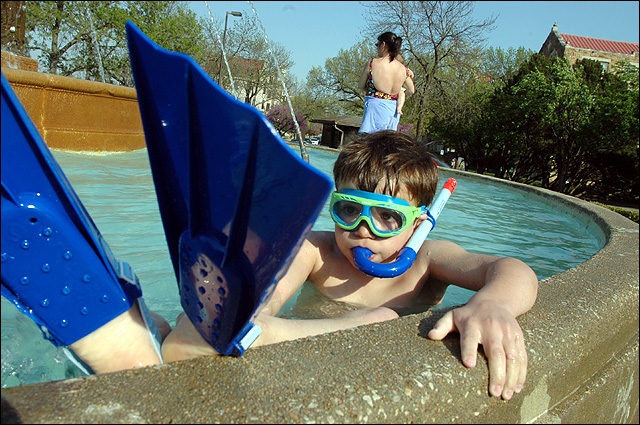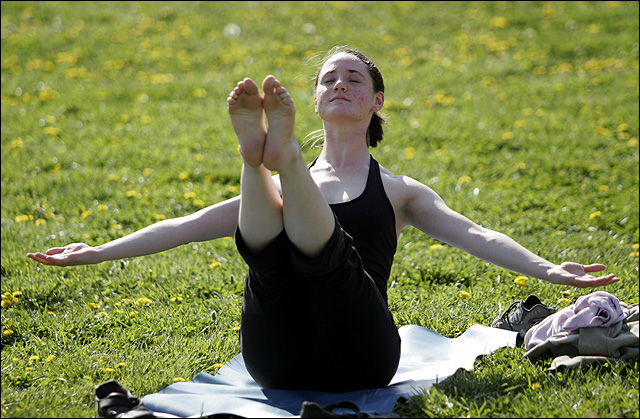Record-breaking heat arrives
Welcome to the 90s.
Summer is still more than two months away, but a record for April 13 was set Thursday afternoon in Lawrence when the thermometer reached 91 degrees shortly after 3 p.m. The old record of 90 degrees was set in 1936, 6News meteorologist Matt Sayers said. The high for Thursday was 93, the National Weather Service reported.
The temperature is going to hover around 87 degrees again today.
“We’re going to be challenging more records,” Sayers said.
Not only is it hot, it also is dry, with only a slight chance of rain for Saturday night, Sayers said.
The normal high for this time of year in Lawrence is about 70 degrees.
Lawrence is having an abnormally dry year, as is much of northeastern and north central Kansas, said Bruce Kintigh, assistant Kansas climatologist.
Most of western and southwestern Kansas and some areas of southeastern Kansas are experiencing a moderate drought, according to the U.S. Drought Monitor. There are extreme drought conditions in southeastern Kansas, southwestern Missouri and northeastern Oklahoma.

Thursday's high temperature of 93 degrees set a record in Lawrence, and the Chi Omega fountain on the Kansas University campus was the perfect place to cool off, as Alexander Miller, 6, and his family discovered.
“Normally southeastern Kansas gets more rain than anywhere else,” Kintigh said. “The drought is expected to persist for now, but it’s worse out west. All the storms have been firing up in central Kansas and moving rapidly east.”
So far this month only about a half-inch of rain has fallen in Lawrence, weather records show. The average rainfall in Lawrence during April is 1.29 inches. There is no sign of improvement anytime soon, Kintigh said.
“All indications are we are going through a somewhat weak La Nina pattern, which means it’s looking warm and dry for the summer,” he said. “We’re already seeing some of that now.”
La Nina is the term used to describe the cooling of the ocean surface off the western coast of South America, which happens once every four to 12 years. It affects the Pacific Ocean and certain weather patterns.
“It’s weakening more than they (weather experts) anticipated, which is good for us,” Kintigh said of La Nina.
Related Video
So far the hot, dry weather hasn’t had an adverse effect on crops and yard plants, but that will change if the current weather pattern continues.
The plants “definitely would benefit from a drink of water, that’s for sure,” said Bruce Chladny, horticultural agent with the Douglas County Extension Service.
Chladny urged property owners with yard plants to get out their watering systems and use them, especially if they recently put down fertilizer or a pre-emergence herbicide.
“Any of those types of things need to be watered before the weeds start to germinate and grow,” he said.

Kathleen O'Conner, Lawrence, holds a yoga stretch on the lawn north of the Lawrence Arts Center, 940 New Hampshire. O'Conner worked out with members of her dance squad, 940 Dance Co., on Thursday morning before rehearsal for the New Works Concert. The performance opens May 5-6 at 7:30 at the Lawrence Arts Center.
Steve Kalb recently finished planting most of his 700 acres of corn on his property near Baldwin. He already had wheat planted. So far he isn’t worried about the warm, dry weather. The subsoil moisture level appears to be good, he said.
“Obviously we are going to need some rain at some point,” Kalb said. “These high, dry winds are going to hurt, but it’s April and surely we are going to get some rain sometime.”
The wheat so far has been unaffected by not only the latest dry and hot spell but also the dry winter, said Bill Wood, agricultural extension agent.
“Wheat is a dry weather crop,” Wood said. “It doesn’t take much to grow wheat.”
Kalb agreed.
“Wheat right now looks exceptional,” he said. “We have really high hopes for it.”







